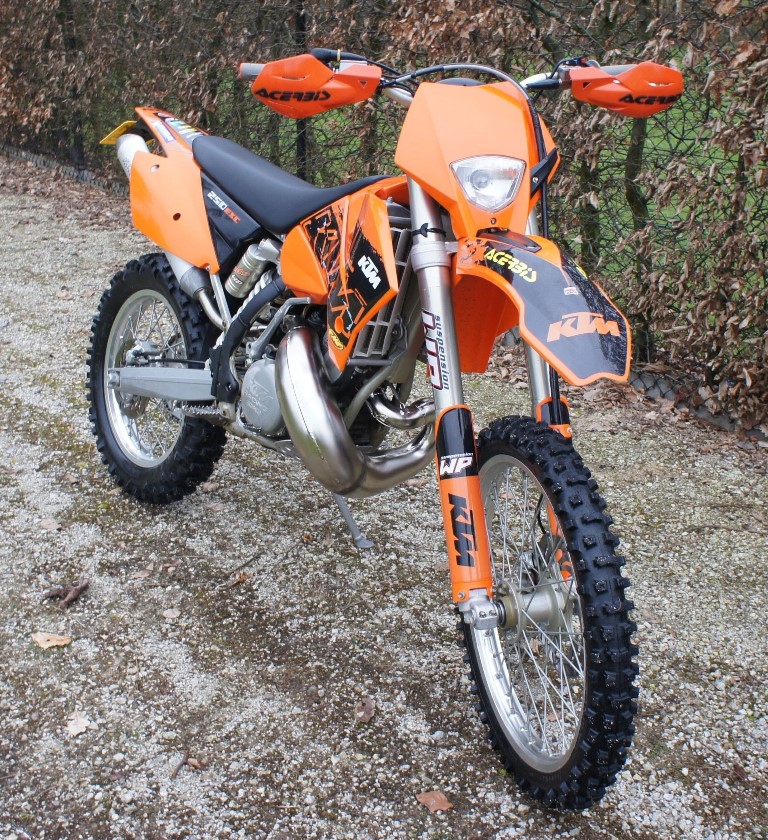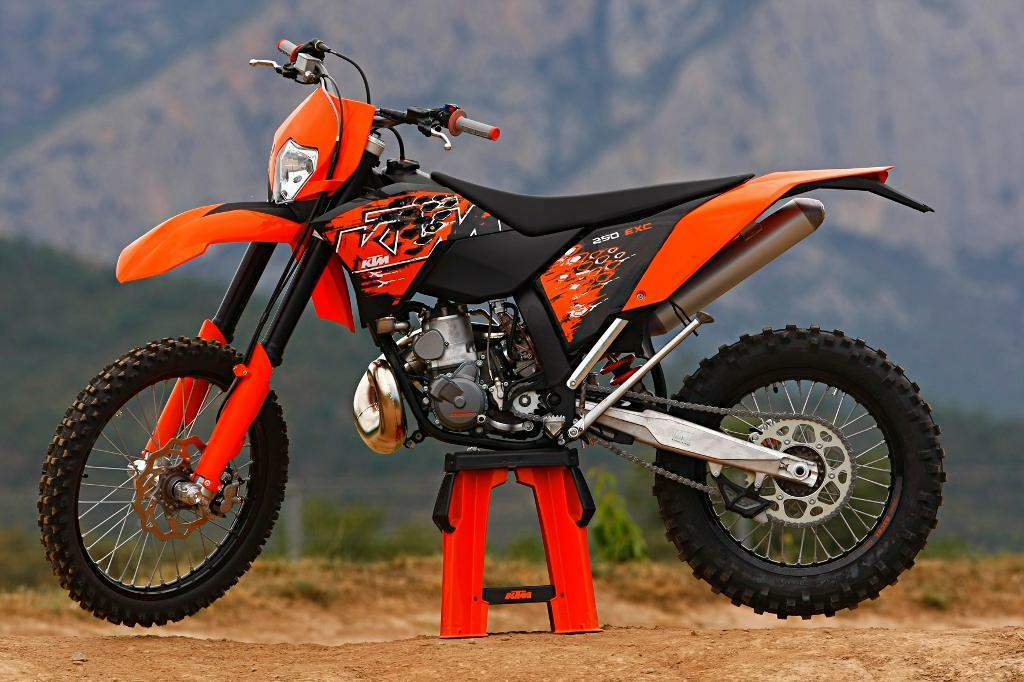
|
|
|
|
|
|
Classic Bikes
Custom Bikes
Individual
Racing Bikes AJP
AJS
Aprilia
Ariel
Avinton / Wakan
Bajaj
Benelli
Beta
Bimota
BMW
Brough Superior
BRP Cam-Am
BSA
Buell / EBR
Bultaco
Cagiva
Campagna
CCM
CF Moto
Combat Motors
Derbi
Deus
Ducati
Excelsior
GASGAS
Ghezzi Brian
Gilera
GIMA
Harley Davidson
Hero
Highland
Honda
Horex
Husaberg
Husqvarna
Hyosung
Indian
Jawa
Kawasaki
KTM
KYMCO
Laverda
Lazareth
Magni
Maico
Mash
Matchless
Mondial
Moto Guzzi
Moto Morini
MV Agusta
MZ / MuZ
NCR
Norton
NSU
Paton
Peugeot
Piaggio
Revival Cycles
Roland Sands
Royal Enfield
Sachs
Sherco
Sunbeam
Suzuki
SWM
SYM
Triumph
TVS
Ural
Velocette
Vespa
Victory
Vincent
VOR
Voxan
Vyrus
Walt Siegl
Walz
Wrenchmonkees
Wunderlich
XTR / Radical
Yamaha
Zero
Video
Technical
Complete Manufacturer List
|
KTM 250 EXC |
| . |
| . |

They produce plenty of useable power with less weight, are less expensive to buy (just under $10K for the 200EXC and just over for the 250EXC) and are easier and cheaper to maintain than most four-strokes. We took them out and gave them a workout to see if they've still got the goods, and walked away with smiles on our faces satisfied there's life left in the old smokers yet. The engines All three of the KTM two-stroke EXC enduro range (the 300EXC was not available to test) have been further developed from the 2005 versions.
The torque that both the 200 and 250 produce is a standout feature of these bikes. This makes the power delivery very flexible, with impressive pulling power from very low revs. The 2006-version KTM powervalve system helps allow a relatively smooth transition into the strong mid and top rev range even more than in recent years; if you haven't ridden a two-stroke with a modern powervalve, you'll be surprised at how effective they are.
Getting them going is very 20th century kickstart only, but firing up two-strokes is usually easy, and these bikes weren't an exception. The 200 has a non-adjustable powervalve, but the 250 (and 300) has a tuneable version which allows you to tune in the type of power and delivery you prefer by changing the tension on the powervalve. There are three colour-coded springs which can be changed to vary how fast the ports open, which changes the nature of the engine quite dramatically, moving the power towards the top, middle or the bottom of the rev range. The red spring is stiffest for high-end performance and the green lightest for the tamest power delivery. The test 250 came with the mid range spring which is the standard fitting and is how we tested the bike. Although we didn't play with them this year, we know from last year's test the change in the engine character is very noticeable with each different spring. There is also a preload adjuster for the powervalve spring, but as we have mentioned previously, KTM recommend not to play with it as it's set in the factory, and can make things worse if not set correctly.
Throttle response is sharp, which is very rewarding when you're on your game, but can put you on your ear if you're not paying attention. There is none of the sudden engine braking typical of four-strokes, which makes backing off for obstacles then putting the power back on a much more flowing transition. The 200 (193cc) runs on a 40:1 pre-mix and drives through a six-speed gearbox while the 250 is 249cc, runs on a 60:1 pre-mix driving through a five-speed gearbox. The spread of gears is well matched on both engines and gear changes are seamless. The 200 transmitted less engine vibration through the bike, not that it was a problem on the 250, but it did make the 200 feel very smooth.
As with all two-strokes, the expansion chamber exhaust is susceptible to damage as I showed when I took an unplanned exit left off the track on the 200. Even though I didn't come off the bike, a log and a large stump managed to bend one of the radiators, pushing the exhaust back onto the radiator hose and pinching a hole in it. Fitting a good quality bash-plate and radiator guards can save you some real heartache on the trails.
The chassis
The EXC's continue on with the Chrome Moly double cradle frame and alloy sub-frame. The 8.5-litre fuel tank hangs down over the engine to keep things narrow and the weight low which gives a reasonable fuel range depending how hard you ride it, anywhere from 85km-120km per tank depending on riding style and conditions. The 200 weighs in 99.8kg and the 250 at 102kg ready to ride, without fuel, which is very competitive. The WP suspension has adjustable compression and rebound damping front and rear, and works well on both bikes, giving a good firm ride for the lighter riders of around 75kg. Initially I found the settings on the 250 a little hard on the small bumps, but backing off the compression and rebound soon made things much smoother.
The forks are big 48mm inverted units and the rear is a low-maintenance linkage-free PDS unit. The steering feels very fast and light which is great in the tight twisty trails, and generally stable and direct for the majority of the time, but can tend to feel nervous on fast rocky or rutted tracks, but as with any design, there are always compromises. KTM has tended toward fast, responsive steering on the EXC's at the cost of some high-speed stability for some years now, and although it generally hasn't been a real big problem, it can be a bit of a worry when the handlebars start tank-slapping at speed. If it becomes a too much of a problem a quick easy and common fix has been to fit a steering damper to increase stability. Lack of steering lock made the bikes feel a little restricted in some really tight situations, which has always been a problem with KTM's.
Brembo brakes are powerful on the front with a light easy lever, quite usable with one finger. At the rear the brake is powerful and can be locked with ease, making it very easy to stall the engine if you're not careful. It may be worth trying a harder compound pad on the rear to make the brake a little less sensitive if it bothers you.
The hydraulic clutch is light and easy to use, and the Renthal tapered alloy handlebars have adjustable mounting positions for individual setup preferences. The bikes don't come with handguards as standard, something most riders will look to rectify pretty quickly. The multipurpose digital readout is neat, compact and functional, back lit for easy viewing in the dark. Comfort has never been high on the priority list for dirt bike manufacturers, but on this occasion I found the seat comfy, slim and easy to move around on, which was a pleasant change and proof that high performance bikes don't HAVE to be a pain in the bum! The bikes haven't escaped the normal yearly decal changes and the new look finishes them off nicely. Verdict KTM continue to turn out great bikes, and these two follow in that tradition. Sometimes less is more, and for the lighter rider the 200 is easier on the scales and the wallet, with a smooth and surprisingly powerful, flexible engine for a bike of its capacity. The 250 of course has a bit more of everything and the extra option of being able to tune the powervalve to the type of power delivery you want.
Whatever the reason you choose a bike, both of these have a lot to offer both the novice and expert, just keep a little money aside for a bash plate, radiator and hand guards - it will probably save you some money and pain in the long run. They blow smoke and you have to kick start them, but the two-bangers still hold plenty of aces, and both of these KTMs are competitive in every way.
Review: Matt O'Connell, CycleTorque

|
Any corrections or more information on these motorcycles will be kindly appreciated. |